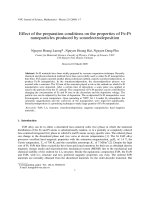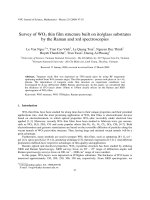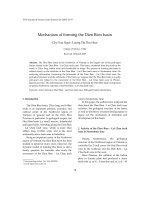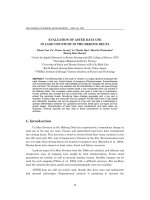Tài liệu Báo cáo " Flora of the Research Forest in Yen Tu, Quang Ninh " docx
Bạn đang xem bản rút gọn của tài liệu. Xem và tải ngay bản đầy đủ của tài liệu tại đây (138.48 KB, 6 trang )
VNU Journal of Science, Natural Sciences and Technology 23 (2007) 194-199
194
Flora of the Research Forest in Yen Tu, Quang Ninh
Nguyen Trung Thanh
1,
*, Phung Van Phe
2
,
Nguyen Nghia Thin
1
1
Department of Biology, College of Science, VNU, 334 Nguyen Trai, Hanoi, Vietnam
2
Department of Forest Plant, Forest University of Vietnam, Xuan Mai, Chuong My, Ha Tay
Received 14 November 2006
Abstract. The vascular flora of the Research Forest in Yen Tu, Quang Ninh was assessed between
2005 and 2006. In the area under review, 721 species belonging to 425 genera and 154 families
were identified. Among these species, these are 9 Lycopodiophyta, 34 Polypodiophyta, 8
Gymnospermae and 670 Angiospermae species (577 Dicotyledonae, 93 Monocotyledonae). The
richest 3 families are Euphorbiaceae with 52 (7.2%) species, Asteraceae with 30 (4.2%) species
and Moraceae with 30 (4.2%) species. The richest genus is Ficus L., (22 species) followed by
Syzygium Gaertn., (8 species) and Dioscorea L., (7 species). When the flora of the area is analysed
by Raunkiaer’s life form system, the results are as follows: phanerophytes 596 (82.7%),
chamaephytes 20 (2.8%), hemicryptophytes 15 (2.1%), cryptophytes 37 (5.1%), therophytes 37
(5.1%), and unknown 16 (2.2%) species, respectively.
Keywords: Vascular plant, Flora, Yen Tu, Quang Ninh Research Forest.
1. Introduction
This research was carried out to determine
the flora of the Research Forest in Yen Tu,
Quang Ninh. The vegetation of the area has
been extensively destroyed by anthropogenic
effects and, therefore, plants try to survive
under unsuitable conditions. On the other hand,
there are not publish in here. Therefore, new
report should be prepared for the conservation
of plant species.
*
The Research Area is located within the
borders of the North by Son Dong district (Bac
Giang province), in the East by Vang Danh
village, in the West by Trang Luong, Dong
Trieu district, and in South by Dong Thi, Uong
Bi district (Quang Ninh province). It is about
_____
* Corresponding author. Tel.: 84-4-8582178.
E-mail:
2686 ha in size, and is located at latitudes
21
o
05' - 21
o
09’ N, and longitudes 106
o
43
’
-
108
o
45’ E.
Yen Tu, Quang Ninh Research Forest is
covered two mainly mountain chains toward to
North from 660m peak to 908m peak and two
junior mountain chains toward North-South.
West is from 660m peak to Vang Tan stream,
and East is from 908m peak to Bai Dau stream.
Altitude in the study area ranges from 50m
Nam Mau plain to 1068m Yen Tu peak. The
study area consist three mainly stream systems
as Vang Tan, Giai Oan and Bai Dau.
Geology
The geological structure of the research area
mostly consists of aged calcareous rocks, paleo-
allvium and sand gravel. There are 4 large soil
groups in the study area as follows:
Nguyen Trung Thanh et al. / VNU Journal of Science, Natural Sciences and Technology 23 (2007) 194-199
195
Yellow ferallitic soil developed in
sandstone in low areas; yellow ferallitic soil
developed in stone gravel belong to hill areas;
yellow-red soil developed in paleoalluvium;
cultivated soil in Nam Mau plain, due to the
climate, topography and differences in the main
substance.
Climate
The typical climate of the region is clearly
two seasons. It characterized by hot, humidity
and rainy summer which starts from May to
October, meanwhile cool and dry winter which
starts from November to April of the next year.
The temperature decreases gradually and the
rain increases towards the upper parts of the
mountains. This characteristic is observed
clearly at 680 - 800m altitude. The temperature
on the area rarely falls below 0
o
C. The annual
average precipitation rate is 1785mm. The
maximum and minimum precipitations were
2700mm and 1423mm, respectively. The
climatic data for this area are based on
observations made by the Region Meteorology
Station. Meanwhile, the annual mean
temperature is 23.4
o
C. The maximum mean
temperature is 33.4
o
C, in June. The minimum
mean temperature is 14
o
C, in December.
However, the temperature also falls down 5
o
C
or lower, sometime. The annual average
maximum and minimum humid rate is 86% and
62%, respectively.
2. Materials and methods
The research material consists of some 2015
plant specimens collected from the research
area. Efforts were made to collect both flowering
and fruiting specimens. The specimens were
prepared according to established herbarium
techniques. Subsequently, the Flora of Vietnam
[1-4] and the other related floras [5-9] and
monographs [10-12] were used in the
identification of the specimens.
Moreover, some of the specimens were
compared with the type specimens which have
been keeping at the Herbarium of Forest
University and National University of Hanoi
(HNU) during the study period between 2005
and 2006. Some other specimens were
determined by expert, Vu Van Can (Forest
Inventory and Planning institute). The most of
the plant specimens are kept at the Herbarium
of University Forest and other are kept at the
Herbarium of National University of Hanoi
(HNU). The flora list and authors were
corrected and given according to the order in
[4,13,14].
3. Results and discussion
This study was carried out with
approximately 2015 vascular plant specimens
collected between 2005 and 2006. As a result of
the identification of the plant specimens, 154
families, 425 genera, and 721 species were
determined. Nine of the 721 species belonging
to the Lycopodiophyta and 34 are
Polypodiophyta and the other 678 belonging to
the spermaphyte plant. Eight species are
Gymnospermae and the others 670 are
Angiospermae, (Table 1).
The dispersion of the plant taxa belonging
to Angiospermae that were defined in the study
area according to the large taxonomical groups
is shown in Table 2. The Dicotyledonae group
are contained by 577 (86.0%) of species, 340
(85.0%) of genus and 110 (83.0%) of family,
meanwhile the Monocotyledonae are included
by 93 (14.0%) of species, 58 (15.0%) of genus
and 23 (17.0%) of family, respectively in the
study area.
Nguyen Trung Thanh et al. / VNU Journal of Science, Natural Sciences and Technology 23 (2007) 194-199
196
Table 1. The dispertion of taxa into large taxonomic groups
Number of families Number of genera
Number of species
Divisions
No % No % No %
Lycopodiophyta 2 1.3 2 0.5 9 1.2
Polypodiophyta 15 9.7 19 4.5 34 4.7
Gymnospermae 4 2.6 6 1.4 8 1.1
Angiospermae 133 86.4 398 93.6 670 93.0
Total 154 100 425 100 721 100
Table 2. The distribution of the species according to the class of Angiospermae
Number of families Number of genera Number of species
Class
No % No % No %
Dicotyledoneae 110 83 340 85 577 86
Monocotyledoneae 23 17 58 15 93 14
Total 133 100 398 100 670 100
As can be seen from Table 3, with 596
(82.7%) of the species are phanerophytes, 20
(2.8%) are chamaephytes, 37 (5.1%) are
cryptophytes, 15 (2.1%) are hemicryptophytes,
37 (5.1%) are therophytes, and 16 (2.2%) are
unknown, respectively. The level of
phanerophyte species is dominate in area study,
others groups are relatively high. Although the
average rainfall per year is 1785mm, most of
the rain falls in August, September and
November. The weather is hot, humid and rainy
from the beginning of May until the end of
October, as a whole. For this reason, it is
normal for the life-forms to be distributed as
they [15].
Table 3. Life-forms
Order Life-form Species
number
Rates
(%)
1 Phanerophytes 596 82.7
2 Chamaephytes 20 2.8
3 Cryptophytes 37 5.1
4 Hemicryptophytes 15 2.1
5 Therophytes 37 5.1
6 Unknown 16 2.2
Total 721 100
The family Euphorbiaceae is the largest in
the study area with 52 (7.2%) species. The next
largest is Asteraceae and Moraceae, represented
as the same by 30 (4.2%) species, followed by
Rubiaceae with 28 (3.9%) species, Lauraceae
with 25 (3.5%) species, Fabaceae with 23
(3.2%) species, Poaceae with 20 (2.8%) species,
Caesalpiniaceae with 18 (2.5%) species,
Fagaceae with 15 (2.1%) species and
Verbenaceae with 13 (1.8%) species. The
Euphorbiaceae are the largest family here,
because they are one of the largest families in
Vietnam. The Asteraceae family is the second
largest family in this area, partly because they
are the largest family in the world as well as in
Vietnam and partly because of the large number
of wild chrysanthenum plants growing in
cultivated areas.
The 10 largest families according to number
of species in this study and the studies
mentioned above are compared in Table 4.
Nguyen Trung Thanh et al. / VNU Journal of Science, Natural Sciences and Technology 23 (2007) 194-199
197
Table 4. The richest families within the areas being compared
Studies performed (species)
Order Family
Yen Tu Cat Ba
Huu Lung Vietnam
1 Euphorbiaceae 52 50 31 425
2 Asteraceae 30 25 20 325
3 Moraceae 30 30 17 -
4 Rubiaceae 28 30 30 400
5 Lauraceae 25 20 14 246
6 Fabaceae 23 30 14 470
7 Poaceae 20 35 17 400
8 Caesalpiniaceae 18 - - -
9 Fagaceae 15 14 - -
10 Verbenaceae 13 18 14 -
11 Acanthaceae - - - 217
12 Cyperaceae - - - 303
13 Orchidaceae - - 18 800
14 Apocynaceae - 15 13 170
The order of the largest families varies only
slightly between studies. In the studies of the
Yen Tu area, the Acanthaceae, Cyperaceae,
Orchidaceae, and Apocynaceae families are not
listed as one of the 10 largest families although
they are one the 10 largest in Vietnam as a
whole. Meanwhile, the family Euphorbiaceae is
the largest family in the studies carried out in
Yen Tu, Cat Ba and Huu Lung areas and is one
the 10 largest in Vietnam as a whole. The
family Asteraceae is the 2
nd
largest family in the
studies carried out in Yen Tu and Huu Lung
and is the 6
th
largest in Cat Ba. In contrast, in
the studies of the Yen Tu, Huu Lung and Cat
Ba areas, the family Moraceae is listed as one
of the 10 largest families although is not one of
the 10 largest in Vietnam as a whole. The
Moraceae family is 3rd in the list from the Yen
Tu, Cat Ba, and 5
th
in the list from Huu Lung
area. Although this appears to be a significant
divergence from the general distribution of
Vietnam flora, the family Moraceae is, in fact,
one of the 10 largest families in East-North
region of Vietnam. As the same Caesalpiniaceae,
Fagaceae, and Verbenaceae occupied 8
th
, 9
th
,
10
th
, in Yen Tu area, respectively. But they are
not listed one of the 10 largest in Vietnam as a
whole. It could be explained by differences in
the habitats of the study area. The other position
in the lists is occupied by Rubiaceae,
Lauraceae, Fabaceae and Poaceae families. This
result was expected because they are one of the
10 largest families in Vietnam as a whole.
The genera containing the highest number
of species in this study and the other studies are
listed in Table 5. The 10 genera containing the
highest number of species vary significantly.
However, each list includes contains between 4
and 8 of the 10 genera containing the highest
number of species. The genera Blumea DC.,
Desmodium Desv., Calamus L., Smilax L.,
Polygonum L., Elaeocarpus L., Sauropus
Blume, Mallotus Lour., which are not among
the 10 largest genera, are also included in the
lists. The genus Calamus L., Cinnamomum
Schaeff., Smilax L., occupy 6
th
, 8
th
, 10
th
position
in Yen Tu, respectively, but it is not listed as
one of the 10 largest genera in the studies
compared. This discrepancy can be explained
by differences in the habitats of the study areas.
As the same, the genus Lithocarpus Blume was
ranked 6
th
in Yen Tu area and Ardisia Sw., was
ranked 4
th
in Huu Lung area. They are one of 10
largest genera in Vietnam, but they are not
occupied in other compared. This discrepancy
also can be explained by differences in the
habitats of the study areas.
Nguyen Trung Thanh et al. / VNU Journal of Science, Natural Sciences and Technology 23 (2007) 194-199
198
Table 5. The richest genera in the studies compared
Studies performed (species)
Order Genera/Family
Yen Tu Cat Ba Huu Lung Vietnam
1 Ficus (Moraceae) 22 12 10 97
2 Syzygium (Myrtaceae) 8 - 6 60
3 Dioscorea (Dioscoreaceae) 7 8 5 39
4 Blumea (Asteraceae) 6 4 - 33
5 Desmodium (Fabaceae) 6 5 8 29
6 Calamus (Poaceae) 6 - - 18
7 Lithocarpus (Fagaceae) 6 - 9 112
8 Cinnamomum (Lauraceae) 6 - - 44
9 Litsea (Lauraceae) 6 6 7 46
10 Smilax (Smilacaceae) 6 - - 29
11 Polygonum (Polygonaceae) - 6 - 36
12 Elaeocarpus (Elaeocarpaceae) - 6 - 39
13 Mallotus (Euphorbiaceae) - 5 6 39
14 Ardisia (Myrsinaceae) - - 7 101
15 Diospyros (Ebenaceae) - - 7 75
16 Sauropus (Euphorbiaceae) - 5 - 23
17 Phyllanthus (Euphorbiaceae) - 5 6 48
The research area is a designated protection
area and is located in one of the centres of plant
diversity in Northern Vietnam. The aim of this
study, now that its total flora has been assessed,
is to help the general population understand the
importance of botanical and environmental
assessment and also to the biodiversity
conservation.
Acknowledgements
The author wishes to thank the Manage
Board of the Yen Tu, Quang Ninh Research
Forest for help during our sample collecting. I
am also grateful to Dr. Niranjana H. Murthy,
Department of Botany, Karnatak University,
India for checking the English manuscript
during the preparation of this paper.
References
[1] L.V. Averyanov., Identification guide to Vietnam
orchids (Orchidaceae Juss.) St. Petersburg,
Russian, World and Family, 1994.
[2] P.H. Ho, Flora of Vietnam, Vol., 1-3, Young
Publishing House of Ho Chi Minh, Vietnam,
1999-2000 (in Vietnamese).
[3] Forest Inventory and Planning institute, Vietnam
Forest Trees, Agriculture Publishing House,
Hanoi, 1971-1988 (in Vietnamese).
[4] The Center for Natural Resources and
Environmental Studies, VNU; Institute of
Ecology and Biological Resources, VAST; The
Netherlands Development Organisation,
Checklist of Plant Species of Vietnam, Vol., 1-3,
Agricuture Publishing House, Hanoi, 2001-2005
(in Vietnamese).
[5] Anonymous, Flora Yunnanica, Vol., 1-7, Yunnan
Science Technology Press, Kunming, China,
1979-1997.
[6] A. Aubreville, M.L. Tardieu, J.E. Vidal et Ph.
Mora (Reds.), Flora du Cambodge, du Laos et du
Vietnam, Fasc. 1-29, Paris, France, 1960-1996.
[7] H. Lecomte (Edit.), Flore generale de l Indo-
chine, 7 tomes, Paris, France, 1907-1951.
[8] A. Petelot, Les plants medicinales du Cambodge,
du Laos et du Vietnam, Archives des Recherches
agronomiques et pastorales du Saigon, Vietnam,
1952-1954.
[9] P. Wu, P. Raven (Eds.), Flora of China. Vol., 3-
79. Beijing & Louis, China, 1994-2002.
[10] D.J. Mabberley, The Plant Book, Cambridge
University Press, UK, 1987.
Nguyen Trung Thanh et al. / VNU Journal of Science, Natural Sciences and Technology 23 (2007) 194-199
199
[11] N.N. Thin, The Manual on Research of
Biodiversity, Agricuture Publishing House,
Hanoi, 1997 (in Vietnamese).
[12] N.T. Thanh, N.N. Thin, D.V. Xy, Floristical
Characteristics of Cham Chu Nature Reserve
Area, J. Science 22, No. 3 (2006) 45, Hanoi,
Vietnam,
[13] R.K. Brummitt, Vascular Plant Famies and
Genera, Royal Botanic Gadens, Kew, UK, 1992.
[14] R.K. Brummitt, C.E. Powell, Authors of Plant
Names, Royal Botanic Gadens, Kew, UK, 1992.
[15] C. Raunkiaer, The life forms of plants and
statistical plant geography, Oxford, Clarendon
Press, 1934, 104 pp.
Kết quả nghiên cứu bước ñầu về hệ thực vật tại rừng ñặc dụng
Yên Tử, Quảng Ninh
Nguyễn Trung Thành
1
, Phùng Văn Phê
2
, Nguyễn Nghĩa Thìn
1
1
Khoa Sinh học, Trường ðại học Khoa học Tự nhiên, ðHQGHN, 334 Nguyễn Trãi, Hà Nội, Việt Nam
2
Bộ môn Thực vật Rừng, Trường ðại học Lâm nghiệp, Xuân Mai, Chương Mỹ, Hà Tây
Rừng ñặc dụng Yên Tử, Quảng Ninh cách thành phố Hạ Long khoảng 40Km và Hà Nội 150Km.
Rừng ở ñây ñược bao bởi hệ giông chính Yên Tử về phía Bắc từ ñỉnh 660m ñến ñỉnh 908m và hai
giông phụ theo hướng Bắc Nam. ðỉnh cao nhất là Yên Tử với ñộ cao 1068m và thấp nhất là Cách
ñồng năm mẫu 50m.
Hệ thực vật tại rừng ñặc dụng Yên Tử, Quảng Ninh ñã ñược tiến hành nghiên cứu từ năm 2005-
2006. Kết quả ban ñầu thu ñược bao gồm 4 ngành với 721 loài thuộc 425 chi và 154 họ. Sự phân bố
các taxon như sau: ngành Thông ñất có 9 loài, tiếp ñến ngành Dương xỉ với 34 loài, ngành Hạt trần
chiếm 8 loài và ngành Hạt kín chiếm số lượng loài lớn nhất với 670 loài (bao gồm 577 loài thuộc lớp
Hai là mầm và 93 loài thuộc lớp Một lá mầm). Khi ñánh giá 10 họ giàu loài thì 3 họ có số loài lớn nhất
là: họ Thầu dầu với 52 (7,2%), tiếp ñến 2 họ Cúc và Dâu tằm có số loài bằng nhau chiếm 30 (4,2%).
Ba chi giàu loài nhất trong số 10 chi giàu loài ñã ñược xác ñịnh, chi Ficus L. (22 loài), tiếp ñến chi
Syzygium Gaertn., (8 loài) và Dioscorea L., (7 loài). Phân tích dạng sống ñã áp dụng theo Raunkiaer,
kết quả thu ñược gồm nhóm chồi trên (Ph) chiếm 596 (82,7%), chồi sát ñất (Ch) với 20 (2,8%), chồi
nửa ẩn (Hm) gồm 15 (2,1%), chồi ẩn (Cr) chiếm 37 (5,1%), cây một năm (Th) có 37 (5,1%) và chưa
xác ñịnh (Unk) chiếm 16 (2,2%) loài.









